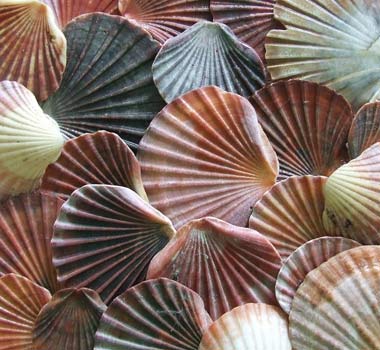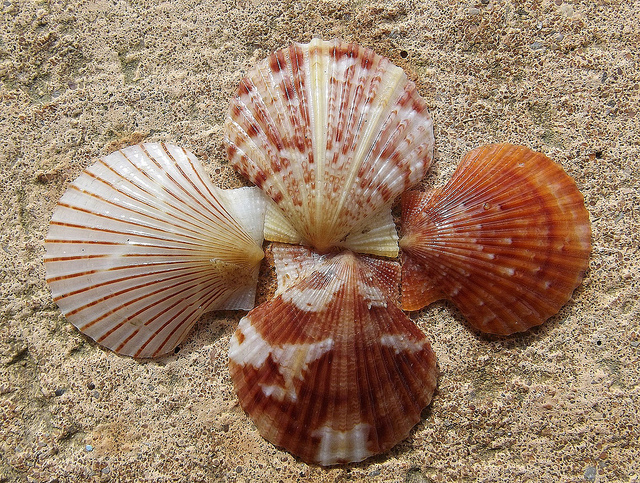Scallop shells; photo by Parée on Flickr (noncommercial use permitted with attribution / share alike).
Official State Shell of New York
New York designated the bay scallop (Argopecten irradians) as the official state shell in 1988. All Aquatic Life Symbols
Bay Scallop Facts
Adult bay scallops can grow to 3 ½ inches (90 mm) and live in shallow coastal bays and estuaries. Bay scallop shells have 13 - 22 ribs stemming from the central point (umbo) of the shell. The color of the top shell (left valve) ranges from drab, dark grey to black or brown, with occasional yellow, orange, or red highlights. The bottom half of the shell (right valve) is usually lighter in color than the top, sometimes pale yellow or white.
Scallops filter-feed by straining microscopic plants (algae) from the water. Bay scallops have 18 pairs of blue eyes set along the margin of the shell which detect shadow and movement. Unlike other species that burrow or attach themselves, adult bay scallops live free and are capable swimmers for short distances (swimming by jetting water through their valves, usually as a response to predators).
Scallops are hermaphrodites (having both male and female sex organs). A one-year old scallop produces an average of 16 million eggs during its spawning period. The eggs develop into swimming larvae with tiny shells, distributed by the water currents. Mortality is very high during the first 2 weeks. Then the larvae drop out of the water stream and change into juvenile scallops. During this metamorphosis, a foot and gills develop, the swimming organ disappears, and the tiny scallops attach to seagrasses or other objects.
The bay scallop was nearly wiped out in the 1930's when eelgrass beds were hit by blight . Eelgrass is an essential part of the bay scallop's habitat - young scallops attach to blades of eelgrass with thin threads (suspending themselves to avoid suffocating silt and predators such as crabs). Although eelgrass has recovered, the scallop has not fully recovered (in part from over-fishing). Because of their scarcity, any bay scallops caught should be returned to their environment.


